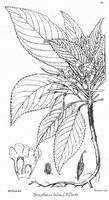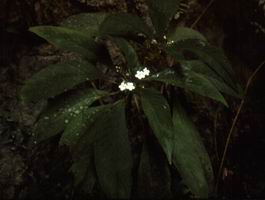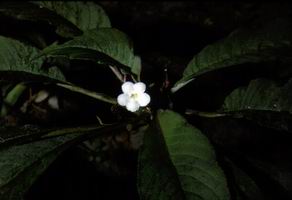
C.B. Clarke, in A. & C. DC, Monogr. phan. 5/1, t. 22 (1883)
Full name and orig.
publication: :
Etymology: From the Greek έξι, hexi = six, and ανδρος, andros = male, pertaining to the stamens. As the anthers of the two lower stamens are bithecous while those of the upper pair are monothecous, the androecium as a whole has six thecae.
Synonyms: -
Infrafamilial position: Didymocarpoid Gesneriaceae - "Advanced Asiatic and Malesian genera" (Weber 2004).
Description: Terrestrial shrubs or lignescent herbs. Stem erect, woody, usually unbranched. Leaves in a dense or spaced tuft at stem apex, opposite or in whorls of three, radially spreading, petiole long, short or ill-defined, lamina lanceolate to broad elliptical-acuminate. Cymes shortly or long pedunculate, with several flowers, bracteoles narrow-oblong to linear. Sepals free nearly to base, linear. Corolla white, with yellow mouth. Corolla infundibuliform, tube short, limb bilabiate, upper lip shorter, lobes rounded. Stamens 4, didynamous; filaments inserted at corolla base; anthers of the two lower stamens bithecous, those of the upper pair monothecous. Nectary absent. Ovary conical, pilose-villose; style short; stigma subbilobed. Fruit cylindrical, subcarnose, breaking irregularly into pieces.
Chromosome number: 2n = 34.
Species number: 4.
Species names (incl. publication and synonyms): See Skog, L.E. & J.K. Boggan. 2005: World checklist of Gesneriaceae: http://persoon.si.edu/Gesneriaceae/Checklist.
Type species: Hexatheca fulva C.B.Clarke
Distribution: Borneo (W Kalimantan, Sarawak to Sabah).
Ecology: Growing on sandstone or limestone rocks, usually with the stem held ± horizontally and with a fan of close-set leaves at the top; in erect-growing plants, however, the leaves are spaced.
Notes: The name refers to the curious organisation of the androecium: the anterior stamens are bithecous, the posterior ones monothecous; thus the androecium as a whole has six thecae. With respect to the subcarnose indehiscent-irregularly breaking fruits the genus was considered to belong to the tribe Cyrtandreae by Clarke (1883) and Burtt (1963), but is better referred to the Didymocarpoid Gesneriaceae (Wiehler & Burtt 1995).
Selected references: Burtt, Notes Roy. Bot. Gard. Edinburgh 46: 53-57 (1989), notes, new sp.
Bibliography: See Skog, L.E. & J.K. Boggan. 2005. Bibliography of the Gesneriaceae. 2nd edition: http://persoon.si.edu/Gesneriaceae/Bibliography.
Illustrations:

|
Hexatheca fulva C.B.Clarke,
type species
C.B. Clarke, in A. & C. DC, Monogr. phan. 5/1, t. 22 (1883) |
 |
 |
Hexatheca fulva C.B.Clarke, type species
Borneo, Sarawak, Bidi Hills, phot. A.Weber (1979) |
last modified: 2007-07-13